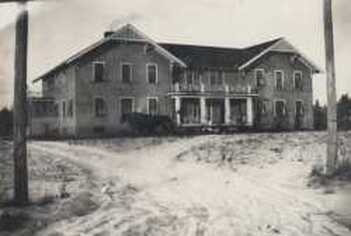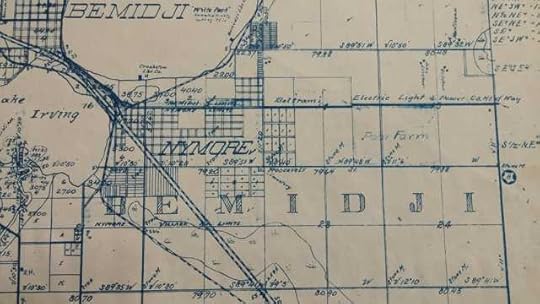Poor Farm
Murder Book now available on Audio!  Thank you everyone for making True Crime Tuesday an incredible success! On the last night, I gave away 5 audio books of Murder Book, and I’m giving away 5 more to people who respond to this blog. My next book, still unnamed, takes place in the St. Cloud and Bemidji areas. Each chapter in book 5 begins with a quote from a John Prine song. I’ve received special permission from his recording studio to do this.
Thank you everyone for making True Crime Tuesday an incredible success! On the last night, I gave away 5 audio books of Murder Book, and I’m giving away 5 more to people who respond to this blog. My next book, still unnamed, takes place in the St. Cloud and Bemidji areas. Each chapter in book 5 begins with a quote from a John Prine song. I’ve received special permission from his recording studio to do this.  Bemidji In 2016, the FBI ranked Bemidji as the most dangerous city in Minnesota, based on the number of violent crimes per capita. With that said, I like Bemidji and enjoy visiting Bemidji. I will give an example of a case only a few years old, and share a little history about a Bemidji “poor farm.”
Bemidji In 2016, the FBI ranked Bemidji as the most dangerous city in Minnesota, based on the number of violent crimes per capita. With that said, I like Bemidji and enjoy visiting Bemidji. I will give an example of a case only a few years old, and share a little history about a Bemidji “poor farm.”
In June of 2016, firefighters respond to a fire at Hillcrest Manor trailer park in Bemidji to find Melissa Norby’s body buried in the rubble. Melissa’s hands were bound with duct tape. Hours into the arson-murder investigation, Amanda Smith tells police officers that Melissa was babysitting her 5-year-old daughter the night of the fire, but the girl was nowhere to be found. She had allowed her daughter to stay at Melissa's house at least 20 different times, as Melissa was someone Amanda trusted and had known for decades.
During a conversation with one of Melissa's friends, investigators soon learn disturbing details about Melissa’s (a single mom) sex life. After analyzing her computer, cell phone records, and talking with close friends they realize Melissa was very into ‘daddy-little girl’ sexual scenarios that she was playing out with her new friend “Chance.” At times the sex was rough, and had even turned violent. A friend thought the relationship “ended in him punching her and choking her out and putting over the back of the SUV and raping her." Detectives learn "Chance's" real name is Jake, and he owns a food truck called Jake's Eats. They immediately recognize him. "We discovered that our dead victim was dating Jacob Kinn. We knew Jacob Kinn, and we went 'Oh my God,'" said BCA Special Agent Chad Museus. Jacob Kinn was a registered sex offender, well-known to law enforcement in Bemidji. "He actually put an ad out on Craigslist asking to take photos of a young girl. And we, the sheriff's office here, sent an undercover deputy, she posed as the mother of a 8- 9-year-old-girl, and he was convicted on some charges related to that."
"We discovered that our dead victim was dating Jacob Kinn. We knew Jacob Kinn, and we went 'Oh my God,'" said BCA Special Agent Chad Museus. Jacob Kinn was a registered sex offender, well-known to law enforcement in Bemidji. "He actually put an ad out on Craigslist asking to take photos of a young girl. And we, the sheriff's office here, sent an undercover deputy, she posed as the mother of a 8- 9-year-old-girl, and he was convicted on some charges related to that."
Jacob Kinn was now the prime suspect in the murder of Melissa Norby, and the kidnapping of a 5-year-old girl. Cops needed to find him quickly. "He was obsessed with child porn. He would, almost continuous throughout the day, access some image-sharing sites of young girls," said BCA Special Agent Paul Gherardi.
Jacob Kinn claims he was fishing on Clear Lake at the time the girl disappeared. But his cell phone records place him near Bigfork, Minnesota. Further examination of his cell phone by Special Agents William Bennet and Jake Hodapp find Melissa had been complicit in the kidnapping of the 5-year-old girl. "She definitely wanted to do anything she could to have a relationship with him, and at all costs," said Jake Hodapp. "Jacob Kinn only maintained that relationship with Melissa because he could have access to a little girl," said Special Agent Paul Gherardi. While Melissa thought she was saving the relationship, Kinn may have planned on killing her from the onset. On the day the girl disappeared, it appears Melissa and Jacob Kinn had sex, and then she was willingly bound and tied up, to make it look like a stranger broke in and abducted the girl. But Kinn didn’t want any witnesses, so he choked her to death, while the 5-year-old waited in the next room. Melissa Norby Minnesota BCA special agents Don Newhouse and Rob Fraik were told to head to Bigfork to start searching for the girl. It was the middle of the night and not a street light in sight. Before leaving the sheriff's station, the agents got a good look at Kinn's Jeep. Newhouse stated, "The undercarriage had a lot of vegetation, grass, yellow and white flowers hanging from the undercarriage, muddy tires. It was pretty clear that he was out, we figured in a wet area, possibly driving in a hayfield or somewhere that he had to go through a lot of grass and wildflowers."
Melissa Norby Minnesota BCA special agents Don Newhouse and Rob Fraik were told to head to Bigfork to start searching for the girl. It was the middle of the night and not a street light in sight. Before leaving the sheriff's station, the agents got a good look at Kinn's Jeep. Newhouse stated, "The undercarriage had a lot of vegetation, grass, yellow and white flowers hanging from the undercarriage, muddy tires. It was pretty clear that he was out, we figured in a wet area, possibly driving in a hayfield or somewhere that he had to go through a lot of grass and wildflowers."
If you’ve ever been to Bigfork, that didn't exactly narrow down the search. “We have a Kinn who owns property in that same area, 3.1 miles from the cellphone tower,” said Chad Museus. Newhouse and Fraik make it to Bigfork just as the sun was coming up. Compliments of Mother Nature, there was a heavy downpour that night. If anyone had driven in the area recently there would be fresh tire marks. The two men start making their way from the cellphone tower to the direction of the ping from Kinn's phone. They found tracks matching the tires on Kinn's Jeep. After about a half-mile, the gravel road came to an end. And it was clear which direction they needed to go.
"Nobody had driven down that road for weeks, except for those tire tracks," said Newhouse. The men get out and start to follow the tracks on foot. "Had it not been for the tracks, we would have been focusing our efforts somewhere else," said Newhouse. After walking about half a mile, detectives spot a camper off in the distance. The tire tracks they were following led right to it.
The door to the camper was taped shut with electrical tape. Fraik removes the tape and slowly opens the door. And there is the 5-year-old girl, alive. Both agents were trembling with adrenaline and joy. Her ankles and legs were taped together. She shows the officers scrapes and bruises on her arms, and says it's the only thing that hurts. It had been a long sleepless night for Amanda Smith, the 5-year-old’s mother. She finally got the phone call she'll never forget. Her daughter is alive and has been rescued. Amanda states with regard to her daughter, “The strength that radiates from her is unbelievable … we are so incredibly thankful.”
It had been a long sleepless night for Amanda Smith, the 5-year-old’s mother. She finally got the phone call she'll never forget. Her daughter is alive and has been rescued. Amanda states with regard to her daughter, “The strength that radiates from her is unbelievable … we are so incredibly thankful.”
About 90 minutes later, Jacob Kinn is spotted behind the wheel of his dad's truck heading north. He's pulled over and taken into custody. "He's located on his way back out to that camper in Bigfork," said Museus. "Either he was going to kill her or move her or hide or do something to keep us from finding her."
Eventually, Kinn admits that after he killed Melissa, he took the child to his home in Bemidji and tied her up. He then went back to Melissa’s trailer home, doused it in gas, and set it on fire. Kinn then returned home, assaulted the child, tied her up again and went to work. When he returned home from work, he took the girl to a pop-up camper he owned near Bigfork and left her there.
Jacob William Kinn, age 33, pled guilty to 2nd Degree Unintentional Murder (claiming Melissa enjoyed being choked and he simply did it too long), Kidnapping, and Criminal Sexual Conduct in the 1st Degree. On June 26, 2017, Kinn was sentenced to 52 years in prison. (As a child molester in prison, that will be hard time.)
The Beltrami County Poor Farm provided shelter and care for elderly and disabled people from 1902 until 1935, when social security replaced the poor farm system. In 1901, the Beltrami County Board of Commissioners decided to purchase land suitable for a farm complex that would care for the county’s poor citizens. While large cities in Minnesota (and across the US) supported poor houses and houses of charity, rural areas established poor farms and tried to make them well run and self-sustaining. Beltrami County was one of the sixty-three Minnesota counties, out of a total of eighty-seven, that maintained a poor farm at some point in its history.
In 1901, the Beltrami County Board of Commissioners decided to purchase land suitable for a farm complex that would care for the county’s poor citizens. While large cities in Minnesota (and across the US) supported poor houses and houses of charity, rural areas established poor farms and tried to make them well run and self-sustaining. Beltrami County was one of the sixty-three Minnesota counties, out of a total of eighty-seven, that maintained a poor farm at some point in its history.
Beltrami County purchased the property on August 2, 1901, in Section 14 of Bemidji Township, directly east of the city limits. They built a main building and a second small building for quarantine and hospital purposes in September 1901. It’s lightly written, but if you look close to the center, right side of this map, you see the location of the poor farm.
It’s lightly written, but if you look close to the center, right side of this map, you see the location of the poor farm.
They took bids to run the farm and H. J. Armstrong, the lowest bidder, was appointed farm superintendent. His salary was fixed at $50 per month, starting on the first day of January 1902. This salary included the services of Mrs. Armstrong as cook and matron. Neighbors hired by the superintendent often helped with outside work; residents who were able to perform labor did so and helped keep the farm functioning.
The Beltrami County Poor Farm was run with great economy. It consisted of a house, a four-story barn, a granary, a pest house, a smoke house, and a root cellar on thirty-two acres of land. The pest house was a separate building and housed people with contagious diseases, particularly diphtheria, smallpox, and typhoid. Epidemics that originated in lumber camps—homes for many farm residents—were a common concern. After the logging era passed, the farm formally became known as the Detention Hospital.
The farm included a “paupers’” cemetery on a two-acre tract of land set aside for that purpose. Beltrami County paid for coffins as well as the services of an undertaker and a gravedigger, who placed an upright board with the name of the deceased and date of death at the head of each grave.
When farm’s main building burned on March 10, 1914, its residents were moved to various locations throughout the city. At that time, there were nine residents (commonly referred to as inmates). In 1920, the county constructed a new building. It opened on April 1, 1920, with a new name: the Beltrami County Infirmary. At the time, it was considered one of the most modern institutions in the Northwest. Locally, it was still referred to as “the poor farm.” After the Social Security Act mandated old-age assistance in 1935, several Minnesota counties closed their poor houses. Ten of them, including Beltrami County, followed a different course of action: selling their poor farms to private buyers. After Beltrami County leased its farm to Arthur Spears, it was no longer regarded as a poor house, and the resident population of the farm quickly grew. In 1937, Arthur Spears bought much of the property, and it became a private facility.
After the Social Security Act mandated old-age assistance in 1935, several Minnesota counties closed their poor houses. Ten of them, including Beltrami County, followed a different course of action: selling their poor farms to private buyers. After Beltrami County leased its farm to Arthur Spears, it was no longer regarded as a poor house, and the resident population of the farm quickly grew. In 1937, Arthur Spears bought much of the property, and it became a private facility.
As decades passed, the farm’s cemetery became a pasture. Grave markers rotted or were lost, and in 1967, Beltrami County sold a portion of the property to a private owner. In 1979, however, it exchanged land deeds with the owner to regain ownership. The land was cleared, fenced, and once again marked off as a cemetery. The records containing information relating to adoptions and illegitimate births from 1904 to 1916 were restricted for 100 years, but are now public information. They would be listed in the State Archives, MN Historical Society in St. Paul under Nymore (Beltrami County).
Conclusion: We need to take care of each other and look out for others.
Thanks for listening,
Frank
I’ve been listening to a variety of music lately, and this song reminded me of being extra caring to the ones you love.
 Thank you everyone for making True Crime Tuesday an incredible success! On the last night, I gave away 5 audio books of Murder Book, and I’m giving away 5 more to people who respond to this blog. My next book, still unnamed, takes place in the St. Cloud and Bemidji areas. Each chapter in book 5 begins with a quote from a John Prine song. I’ve received special permission from his recording studio to do this.
Thank you everyone for making True Crime Tuesday an incredible success! On the last night, I gave away 5 audio books of Murder Book, and I’m giving away 5 more to people who respond to this blog. My next book, still unnamed, takes place in the St. Cloud and Bemidji areas. Each chapter in book 5 begins with a quote from a John Prine song. I’ve received special permission from his recording studio to do this.  Bemidji In 2016, the FBI ranked Bemidji as the most dangerous city in Minnesota, based on the number of violent crimes per capita. With that said, I like Bemidji and enjoy visiting Bemidji. I will give an example of a case only a few years old, and share a little history about a Bemidji “poor farm.”
Bemidji In 2016, the FBI ranked Bemidji as the most dangerous city in Minnesota, based on the number of violent crimes per capita. With that said, I like Bemidji and enjoy visiting Bemidji. I will give an example of a case only a few years old, and share a little history about a Bemidji “poor farm.”In June of 2016, firefighters respond to a fire at Hillcrest Manor trailer park in Bemidji to find Melissa Norby’s body buried in the rubble. Melissa’s hands were bound with duct tape. Hours into the arson-murder investigation, Amanda Smith tells police officers that Melissa was babysitting her 5-year-old daughter the night of the fire, but the girl was nowhere to be found. She had allowed her daughter to stay at Melissa's house at least 20 different times, as Melissa was someone Amanda trusted and had known for decades.
During a conversation with one of Melissa's friends, investigators soon learn disturbing details about Melissa’s (a single mom) sex life. After analyzing her computer, cell phone records, and talking with close friends they realize Melissa was very into ‘daddy-little girl’ sexual scenarios that she was playing out with her new friend “Chance.” At times the sex was rough, and had even turned violent. A friend thought the relationship “ended in him punching her and choking her out and putting over the back of the SUV and raping her." Detectives learn "Chance's" real name is Jake, and he owns a food truck called Jake's Eats. They immediately recognize him.
 "We discovered that our dead victim was dating Jacob Kinn. We knew Jacob Kinn, and we went 'Oh my God,'" said BCA Special Agent Chad Museus. Jacob Kinn was a registered sex offender, well-known to law enforcement in Bemidji. "He actually put an ad out on Craigslist asking to take photos of a young girl. And we, the sheriff's office here, sent an undercover deputy, she posed as the mother of a 8- 9-year-old-girl, and he was convicted on some charges related to that."
"We discovered that our dead victim was dating Jacob Kinn. We knew Jacob Kinn, and we went 'Oh my God,'" said BCA Special Agent Chad Museus. Jacob Kinn was a registered sex offender, well-known to law enforcement in Bemidji. "He actually put an ad out on Craigslist asking to take photos of a young girl. And we, the sheriff's office here, sent an undercover deputy, she posed as the mother of a 8- 9-year-old-girl, and he was convicted on some charges related to that."
Jacob Kinn was now the prime suspect in the murder of Melissa Norby, and the kidnapping of a 5-year-old girl. Cops needed to find him quickly. "He was obsessed with child porn. He would, almost continuous throughout the day, access some image-sharing sites of young girls," said BCA Special Agent Paul Gherardi.
Jacob Kinn claims he was fishing on Clear Lake at the time the girl disappeared. But his cell phone records place him near Bigfork, Minnesota. Further examination of his cell phone by Special Agents William Bennet and Jake Hodapp find Melissa had been complicit in the kidnapping of the 5-year-old girl. "She definitely wanted to do anything she could to have a relationship with him, and at all costs," said Jake Hodapp. "Jacob Kinn only maintained that relationship with Melissa because he could have access to a little girl," said Special Agent Paul Gherardi. While Melissa thought she was saving the relationship, Kinn may have planned on killing her from the onset. On the day the girl disappeared, it appears Melissa and Jacob Kinn had sex, and then she was willingly bound and tied up, to make it look like a stranger broke in and abducted the girl. But Kinn didn’t want any witnesses, so he choked her to death, while the 5-year-old waited in the next room.
 Melissa Norby Minnesota BCA special agents Don Newhouse and Rob Fraik were told to head to Bigfork to start searching for the girl. It was the middle of the night and not a street light in sight. Before leaving the sheriff's station, the agents got a good look at Kinn's Jeep. Newhouse stated, "The undercarriage had a lot of vegetation, grass, yellow and white flowers hanging from the undercarriage, muddy tires. It was pretty clear that he was out, we figured in a wet area, possibly driving in a hayfield or somewhere that he had to go through a lot of grass and wildflowers."
Melissa Norby Minnesota BCA special agents Don Newhouse and Rob Fraik were told to head to Bigfork to start searching for the girl. It was the middle of the night and not a street light in sight. Before leaving the sheriff's station, the agents got a good look at Kinn's Jeep. Newhouse stated, "The undercarriage had a lot of vegetation, grass, yellow and white flowers hanging from the undercarriage, muddy tires. It was pretty clear that he was out, we figured in a wet area, possibly driving in a hayfield or somewhere that he had to go through a lot of grass and wildflowers."
If you’ve ever been to Bigfork, that didn't exactly narrow down the search. “We have a Kinn who owns property in that same area, 3.1 miles from the cellphone tower,” said Chad Museus. Newhouse and Fraik make it to Bigfork just as the sun was coming up. Compliments of Mother Nature, there was a heavy downpour that night. If anyone had driven in the area recently there would be fresh tire marks. The two men start making their way from the cellphone tower to the direction of the ping from Kinn's phone. They found tracks matching the tires on Kinn's Jeep. After about a half-mile, the gravel road came to an end. And it was clear which direction they needed to go.
"Nobody had driven down that road for weeks, except for those tire tracks," said Newhouse. The men get out and start to follow the tracks on foot. "Had it not been for the tracks, we would have been focusing our efforts somewhere else," said Newhouse. After walking about half a mile, detectives spot a camper off in the distance. The tire tracks they were following led right to it.
The door to the camper was taped shut with electrical tape. Fraik removes the tape and slowly opens the door. And there is the 5-year-old girl, alive. Both agents were trembling with adrenaline and joy. Her ankles and legs were taped together. She shows the officers scrapes and bruises on her arms, and says it's the only thing that hurts.
 It had been a long sleepless night for Amanda Smith, the 5-year-old’s mother. She finally got the phone call she'll never forget. Her daughter is alive and has been rescued. Amanda states with regard to her daughter, “The strength that radiates from her is unbelievable … we are so incredibly thankful.”
It had been a long sleepless night for Amanda Smith, the 5-year-old’s mother. She finally got the phone call she'll never forget. Her daughter is alive and has been rescued. Amanda states with regard to her daughter, “The strength that radiates from her is unbelievable … we are so incredibly thankful.”About 90 minutes later, Jacob Kinn is spotted behind the wheel of his dad's truck heading north. He's pulled over and taken into custody. "He's located on his way back out to that camper in Bigfork," said Museus. "Either he was going to kill her or move her or hide or do something to keep us from finding her."
Eventually, Kinn admits that after he killed Melissa, he took the child to his home in Bemidji and tied her up. He then went back to Melissa’s trailer home, doused it in gas, and set it on fire. Kinn then returned home, assaulted the child, tied her up again and went to work. When he returned home from work, he took the girl to a pop-up camper he owned near Bigfork and left her there.
Jacob William Kinn, age 33, pled guilty to 2nd Degree Unintentional Murder (claiming Melissa enjoyed being choked and he simply did it too long), Kidnapping, and Criminal Sexual Conduct in the 1st Degree. On June 26, 2017, Kinn was sentenced to 52 years in prison. (As a child molester in prison, that will be hard time.)
The Beltrami County Poor Farm provided shelter and care for elderly and disabled people from 1902 until 1935, when social security replaced the poor farm system.
 In 1901, the Beltrami County Board of Commissioners decided to purchase land suitable for a farm complex that would care for the county’s poor citizens. While large cities in Minnesota (and across the US) supported poor houses and houses of charity, rural areas established poor farms and tried to make them well run and self-sustaining. Beltrami County was one of the sixty-three Minnesota counties, out of a total of eighty-seven, that maintained a poor farm at some point in its history.
In 1901, the Beltrami County Board of Commissioners decided to purchase land suitable for a farm complex that would care for the county’s poor citizens. While large cities in Minnesota (and across the US) supported poor houses and houses of charity, rural areas established poor farms and tried to make them well run and self-sustaining. Beltrami County was one of the sixty-three Minnesota counties, out of a total of eighty-seven, that maintained a poor farm at some point in its history.
Beltrami County purchased the property on August 2, 1901, in Section 14 of Bemidji Township, directly east of the city limits. They built a main building and a second small building for quarantine and hospital purposes in September 1901.
 It’s lightly written, but if you look close to the center, right side of this map, you see the location of the poor farm.
It’s lightly written, but if you look close to the center, right side of this map, you see the location of the poor farm.
They took bids to run the farm and H. J. Armstrong, the lowest bidder, was appointed farm superintendent. His salary was fixed at $50 per month, starting on the first day of January 1902. This salary included the services of Mrs. Armstrong as cook and matron. Neighbors hired by the superintendent often helped with outside work; residents who were able to perform labor did so and helped keep the farm functioning.
The Beltrami County Poor Farm was run with great economy. It consisted of a house, a four-story barn, a granary, a pest house, a smoke house, and a root cellar on thirty-two acres of land. The pest house was a separate building and housed people with contagious diseases, particularly diphtheria, smallpox, and typhoid. Epidemics that originated in lumber camps—homes for many farm residents—were a common concern. After the logging era passed, the farm formally became known as the Detention Hospital.
The farm included a “paupers’” cemetery on a two-acre tract of land set aside for that purpose. Beltrami County paid for coffins as well as the services of an undertaker and a gravedigger, who placed an upright board with the name of the deceased and date of death at the head of each grave.
When farm’s main building burned on March 10, 1914, its residents were moved to various locations throughout the city. At that time, there were nine residents (commonly referred to as inmates). In 1920, the county constructed a new building. It opened on April 1, 1920, with a new name: the Beltrami County Infirmary. At the time, it was considered one of the most modern institutions in the Northwest. Locally, it was still referred to as “the poor farm.”
 After the Social Security Act mandated old-age assistance in 1935, several Minnesota counties closed their poor houses. Ten of them, including Beltrami County, followed a different course of action: selling their poor farms to private buyers. After Beltrami County leased its farm to Arthur Spears, it was no longer regarded as a poor house, and the resident population of the farm quickly grew. In 1937, Arthur Spears bought much of the property, and it became a private facility.
After the Social Security Act mandated old-age assistance in 1935, several Minnesota counties closed their poor houses. Ten of them, including Beltrami County, followed a different course of action: selling their poor farms to private buyers. After Beltrami County leased its farm to Arthur Spears, it was no longer regarded as a poor house, and the resident population of the farm quickly grew. In 1937, Arthur Spears bought much of the property, and it became a private facility.As decades passed, the farm’s cemetery became a pasture. Grave markers rotted or were lost, and in 1967, Beltrami County sold a portion of the property to a private owner. In 1979, however, it exchanged land deeds with the owner to regain ownership. The land was cleared, fenced, and once again marked off as a cemetery. The records containing information relating to adoptions and illegitimate births from 1904 to 1916 were restricted for 100 years, but are now public information. They would be listed in the State Archives, MN Historical Society in St. Paul under Nymore (Beltrami County).
Conclusion: We need to take care of each other and look out for others.
Thanks for listening,
Frank
I’ve been listening to a variety of music lately, and this song reminded me of being extra caring to the ones you love.
Published on May 07, 2020 10:27
No comments have been added yet.



